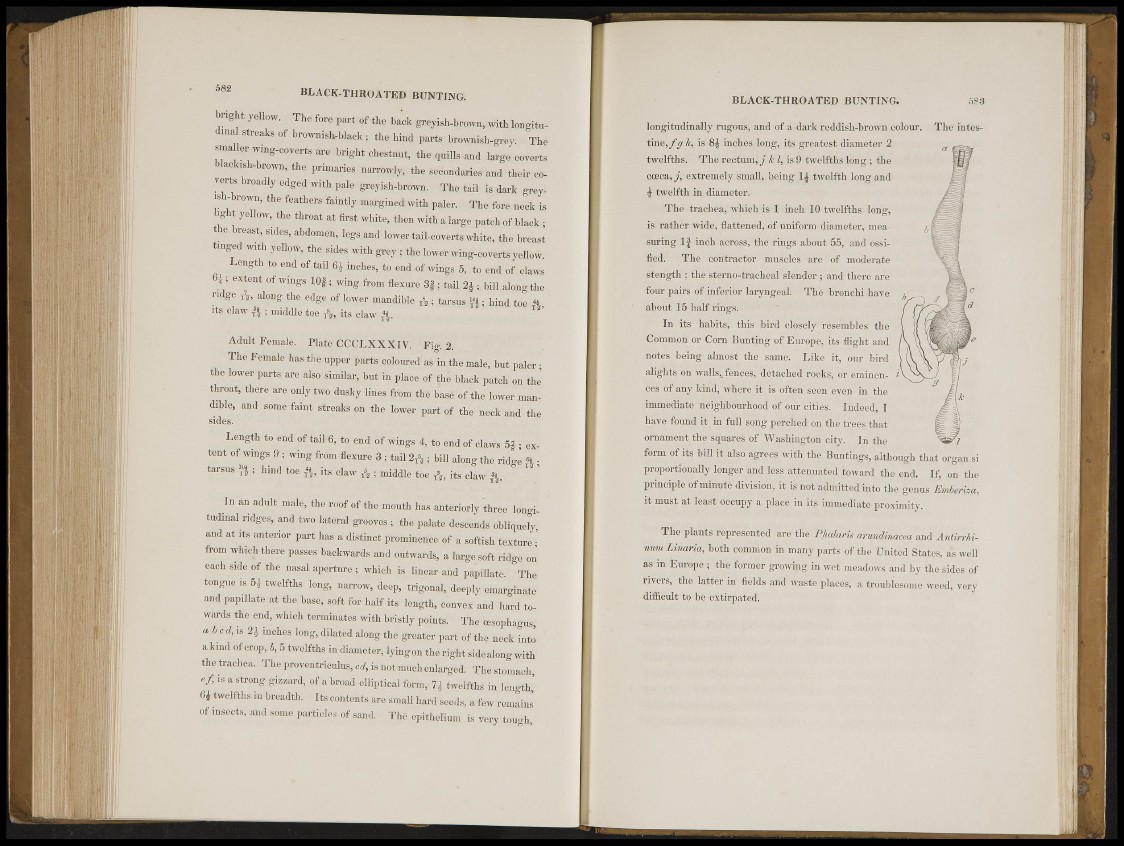
582 BliACK-THHOAf» KCXTING.
bright voUow. Thè fore part of the back greyish-ln^n, with longitul
l , n a l ' S t n , a k s o t ' trowmsfcMaek : » »Ma i p a r h bro« mSh-gr,.y -Th,,
smaller wwg-court s are bright ctestnmt, the quills ,ahd large coverte
Waok,,W,r„vv„,tho primaries « »wl y , the secondaries'and their coverts,
broadly edged with pat e greyish-b«,wn. The ¿ M s dart g*ey.
I H H S H ffie 'V a l h < ! r s fi,intl-v paler. The fore nock is
ight yellow, the throat at first white, then with alarge patch offclack ;
the breast.-sides, abdomen, legs and l„wor,nU.c„v„rts white, fee breast
tmged with yeto#, the sides with grey; th>e tower wing-HbVerts yellow
Length I end of tail 6* inches, .¿end of wings 5, to end of claw
• f a e x t e n t of w m m I.)fI wing fr„„, figure: 3f ; tail 2£ I bill M l
ridge jg, along the edge of lower mandible A ; tarsus. «1; hind toe % '
it|elawT
6 i middle toe A , its daw i t *T
Adult f emale. l'Iato COCLXXXIV. Fig. 2.
The Female has the upper parts coloured» ,as in the male, but paler •
the lower part s are Uso similar, but in place of the black patch on thi
throat, there are only two dusky lines from the base Of the lower mandible,
and some M a t streais on the lower part of the neck and the
I ìwSkSB
Length • f f l ^ H 0f wings 4, to end tf claws 5f •
fct of wAgs 9 , wing from fleare 3, tail 2 $ j $ p atong te ridge % -
t » W § ^ l aWo e ^ , its claw f * ; middle tòe A, its claw
In an tfftfe male, W & o f of the mouth has anteriorly 'three fei '
tudinal ridges, and two lateral grooves ; the palate descends obliquely
and at its antefior part has a distinct frominence of a softish texture •'
from which there passes backwards and outwards, a large goft-ridge on
eàch side of the nasal aperture; which is linear and papillate The
tongue is, Hi twelfths long, narrow, deep, trigonal, deeply emarginate
and papillàté; at the base, soft for half its- length, convex and hur,(towards
the end, which terminates with bristly points. The oesophagus
« bod, is 2i inches long, dilated along the greater part of the neck into
aland of crop, b, 5 twelfths »di ame t e r , lying oh the riglk side along with
the trachea-, The p r o v e n i e n t e , ^ , is'sot„iichenlarged, Thestomaeh
é f , is a Strong gizzard, of a broail g p t i c a l for^, 7* twelfths in length'
6J twelfths'in breadth. Ih contents are small hard seeds, a few remains'
Of insects, and some particles of Sand. The epithelium is very tough
BLACK-THROATED BUNTING.
longitudinally rugous, and of a dark reddish-brown colour. The intest
i n e , / ^ A, is 84 inches long, its greatest diameter 2 a
twelfths. The rectum, / i / , ' is9 twelfths liiug; the Ig f
coeca,/;extremely small, being twelfth long and
4 twelfth in. diameter.
The' trachea, which is 1 - inch 10 twelfths long,
is rather wide, flattened, of uniform diameter, measuring
I f inch across, the rings about 55, and ossified.
'Phi; contractor nmsjilfts' are of moderate
stength : the sterno-trachoal slender-; and there are
four pairs of inferior laryngeal. The bronchi have: ^ . f Wme
about 15 half rings " f (f^jgM^M^
In its habits, this bird closely resembles the I fjf « • ¡ ¡ ¡ ¡ M
Common or Corn Bunting of Europe, its flight and \ VI vMSBJ *
notes being almost the same, Like it,, our bird ) ( V \ y ®
alights on walls,.fences, detached rocks, or eminen- .' ||
cos of any kind, where it is often seen even in the ' ' , v';'' M .
immediate neighbourhood of our cities Indeed, I M\
Kave' found it in full song perched on the trees that fj | J)
ornament the square's of Washington city. In the ^M l
form of its bill it .also agrees with the Huntings, although that organ si
proportionally longer and loss attenuated toward the end. If, on the
principle of minute division, it is not admitted into the genus Emberiza,
it must at least occupy a place it, its immediate proximity.
The plants represented are the I'hahtru armdlnaaa and Antirrhinum
Unaria, both common in,many parts of the United States, as well
as'ih Europe,; the former growing in wet meadows and by the sides of
rivers, the latter in fields and waste places, a troublesome weed, very
difficult to be extirpated.